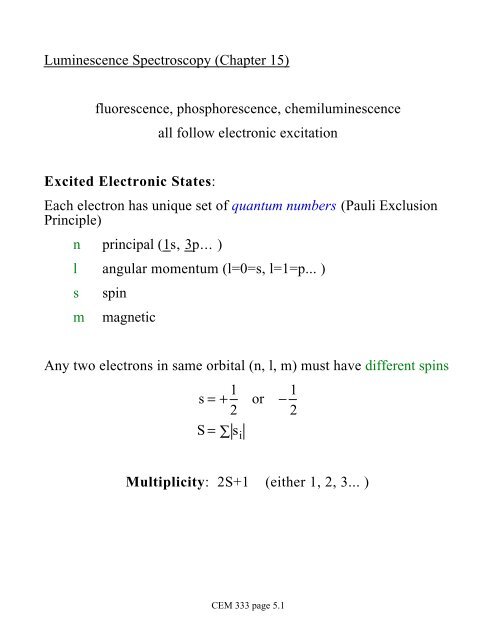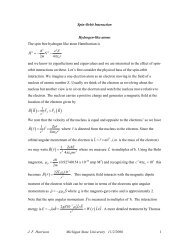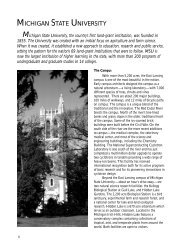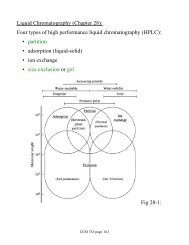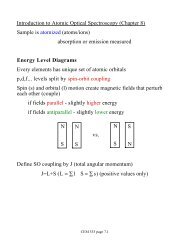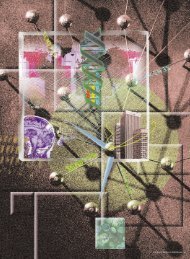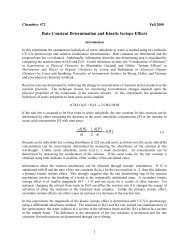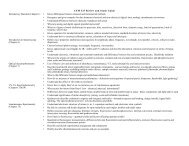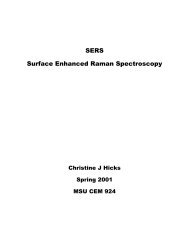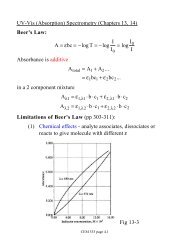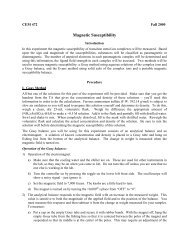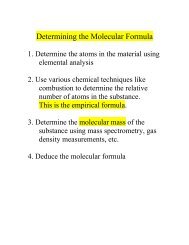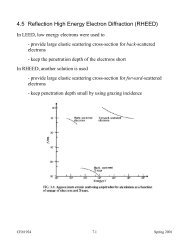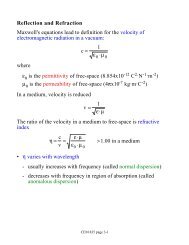Luminescence Spectroscopy (Chapter 15) fluorescence ...
Luminescence Spectroscopy (Chapter 15) fluorescence ...
Luminescence Spectroscopy (Chapter 15) fluorescence ...
You also want an ePaper? Increase the reach of your titles
YUMPU automatically turns print PDFs into web optimized ePapers that Google loves.
What about Lifetimes?• Absorption:S 1 ←S 0 very fast 10-<strong>15</strong>-10-13 s• Relaxation:Resonant emission S 1 →S 0 fast 10-9-10-5 s (<strong>fluorescence</strong>)common in atomsstrong absorber ⇒ shorter lifetimeNon-resonant emission S 1 →S 0 fast 10-9-10-5 s (<strong>fluorescence</strong>)common in moleculesv. fast vibrational relaxationred shifted emission (Stokes shift)CEM 333 page 5.4Fig. <strong>15</strong>-2
Non-resonant emission T 1 →S 0 slow 10-5-10 s (phosphorescence)Transitions between states of different multiplicities are improbable"forbidden" (e.g. T←S or T→S)Fig. <strong>15</strong>-3phosphorescence<strong>fluorescence</strong>excitationCEM 333 page 5.5
Internal Conversion:radiationless transition to lower state whenvibrational energy levels "match"External Conversion: radiationless transition to lower state bycollisional deactivationIntersystem Crossing: transition with spin change (e.g. S to T)Fluorescence:emission not involving spin change (e.g.S→S, T→T), efficient, short-lived 10-5 sDissociation:excitation to vibrational state with enoughenergy to break bondPredissociation:relaxation to state with enough energy tobreak bondCEM 333 page 5.6
Energy Level Diagram: (Fig. <strong>15</strong>-1)CEM 333 page 5.7
How likely is <strong>fluorescence</strong>?Fluorescence Quantum Yield - ratio of number of moleculesfluorescing to number excitedΦ fluor =# photons fluor# species excited(Φ fluor = 0.0 to 1.0)=k fluork fluor + k int con + k ext con + k ISC + k pre dis + k disWhat Factors Affectfluor?(1) Excitation λShort λ's break bonds increase k pre-dis and k disrarely observedmost commonσ* → σ π* → n π* → πemission usually from lowest lying excited state(2) Lifetime of stateTransition probability measured by εLarge ε implies short lifetimeLargest <strong>fluorescence</strong> from short lifetime/high ε stateπ*→π > π*→n (10-9-10-7 s > 10-7-10-5 s)CEM 333 page 5.8
(3) StructureFew conjugated aliphatics fluoresceMany aromatics fluoresceDesire short lifetime S 1 , no/slowly accessible T 1Fluorescence increased by # fused rings and substitution on/inringNHNPyridineNPyrroleNQuinolineIndole(4) RigidityRigid structures fluoresceIncrease in <strong>fluorescence</strong> with chelationFluoreneBiphenyl(5) Temperature, pH, solvent (p 363-364)CEM 333 page 5.9
Quantitative <strong>Luminescence</strong> Spectrophotometry:Fluorescence }FAbsorbed( )678= K' I 0 − I= K'⋅2.303εbc ⋅I 0= K⋅ cOnly works at low A (
Fluorometer - filters to isolate excitation and <strong>fluorescence</strong>wavelengths (but no scanning)Spectrofluorometer - two monochromators for excitation scanning or<strong>fluorescence</strong> scanningFig <strong>15</strong>-7CEM 333 page 5.11
Total <strong>Luminescence</strong> Measurements:Fig <strong>15</strong>-8CEM 333 page 5.12
Chemiluminescence: (see www article)Reaction produces molecule in electronically excited stateA + B → C * + DExample:C * → C + hνNO + O 3 → NO * 2 + O 2NO * 2 → NO 2 + hν (600 − 2800 nm)Used to detect NO from 1 ppb to 10 pptIntensity depends on rate of reaction of production of C*[ ]I CL = φ CLd C *dtFig. <strong>15</strong>-11Advantages: (i) simple instrumentation (no excitation hν) (ii) highsensitivity (ppm to


